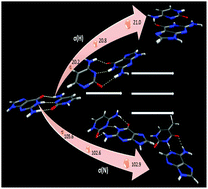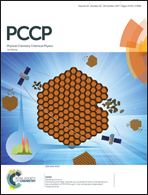Intermolecular magnetic interactions in stacked DNA base pairs†
Abstract
The influence of pi-stacking on the magnetic properties of atoms that belong to adenine–thymine and guanine–cytosine pairs in sequences of three and five layers of DNA base pairs was analysed. As probes we used NMR spectroscopic parameters, which are among the most useful tools to learn about the transmission of magnetic interactions in molecules. Four DFT functionals were employed: B3LYP, BHANDLYP, KT2 and KT3, together with the SOPPA method. Besides, given that the number of non-hydrogen atoms of the supramolecular systems studied here is larger than 50 we applied a locally dense basis set scheme. Our results show that the piling up of a few Watson–Crick base pairs above and below a given pair modifies its NMR spectroscopic parameters by an amount that may be measurable and the percentage of variation does not depend on dispersion. We found that magnetic shieldings are more sensitive than J-couplings, and also that some atoms are more sensitive than others. Stacking affects the shielding of non-hydrogen atoms like nitrogens, that are donors in hydrogen bonds, HBs, and the carbons bonded to them. The amount of variation of these shieldings was found to be from 2% to 5% when the pairs are considered first as isolated, and then, placed in the middle of a sequence of three layers of base pairs. Such a variation becomes vanishingly small when the sequence contains more than three layers, showing that the stacking effect on NMR spectroscopic parameters has a local nature. We have also found a pattern for shieldings. First, equivalent atoms of similar monomers (thymine and adenine, or guanine and cytosine) have similar values of absolute shieldings in isolated pairs, and the amount of variation from isolated pairs to aggregates of a few pairs is also similar, meaning that equivalent atoms are affected in a similar manner by pi-stacking. Second, the hydrogen atoms which belong to hydrogen bonds are more sensitive to the piling up than the non-hydrogen atoms.



 Please wait while we load your content...
Please wait while we load your content...